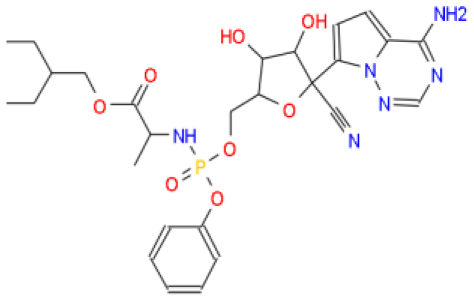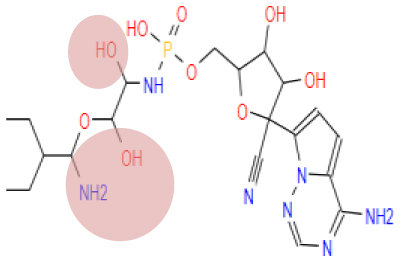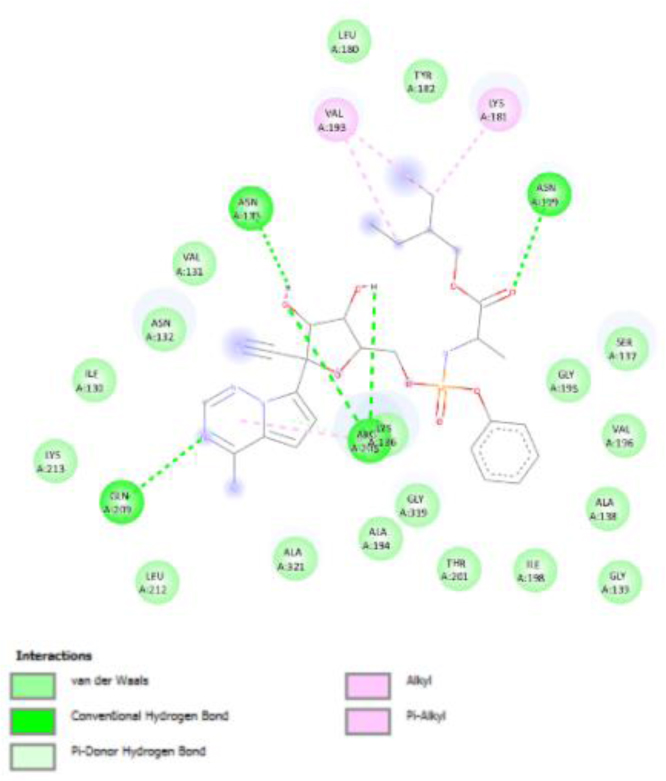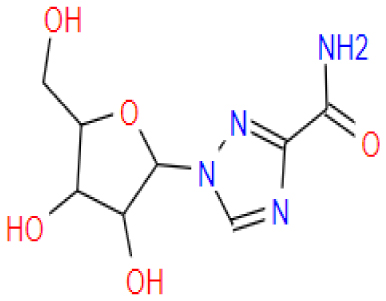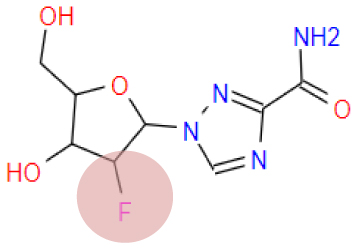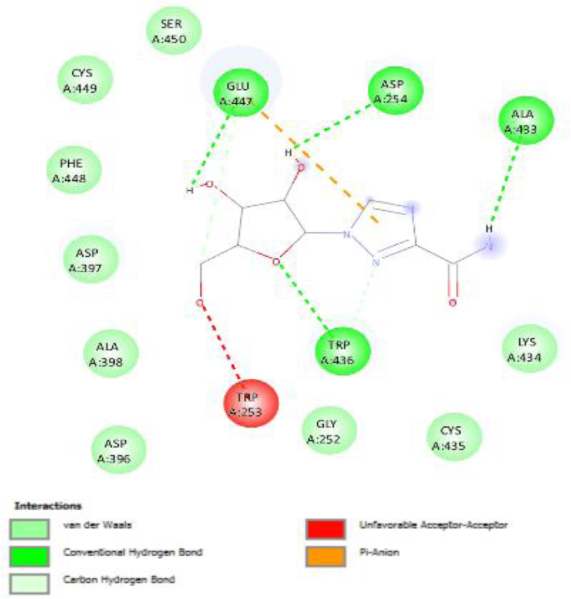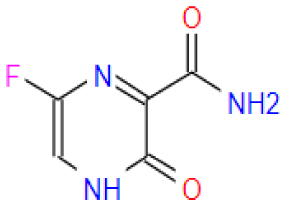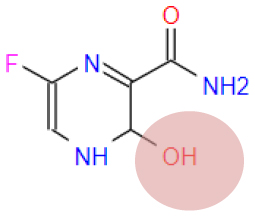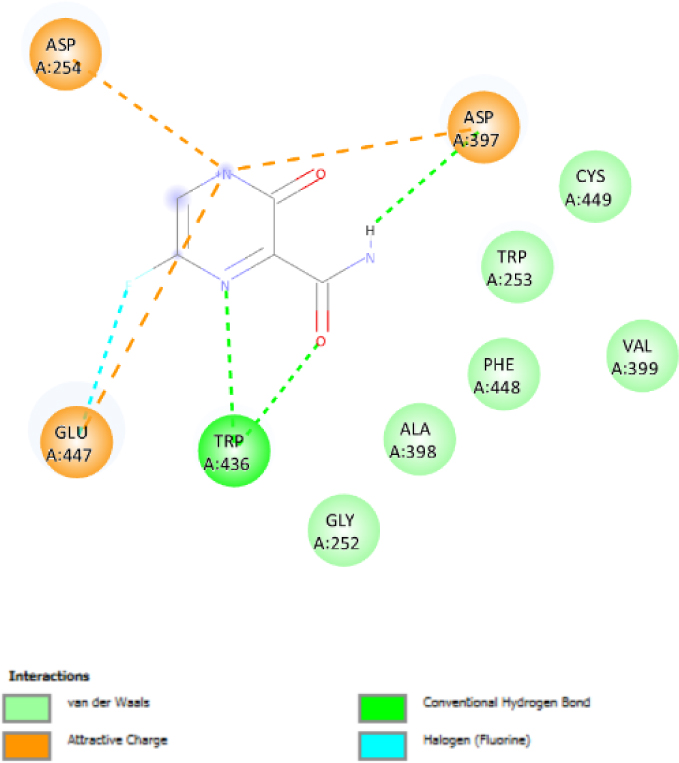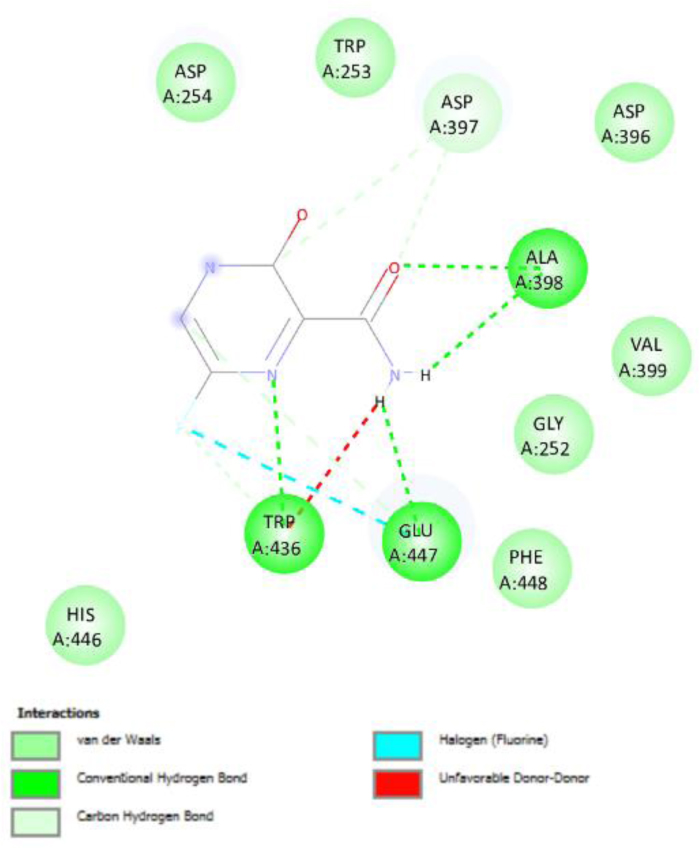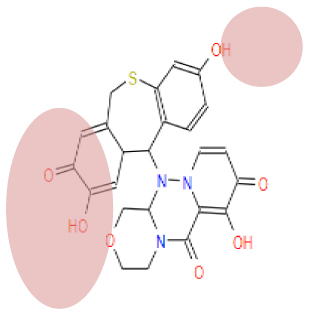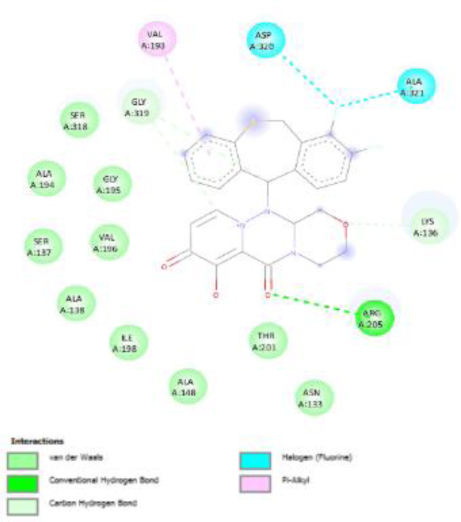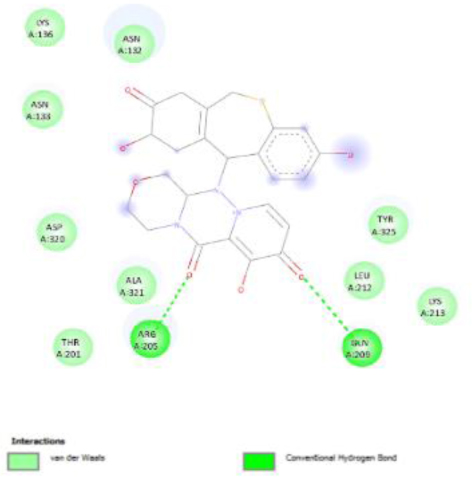1.
Introduction
The recent pandemic, caused by a new member of the Coronavirus family, i.e., SARS-CoV-2, led to COVID-19, which caused an enormous number of morbidities and mortalities worldwide [1]. About 772,011,164 total cases and 6,979,786 deaths have been reported as of November 16, 2023 [2]. Viral pathogenicity is dependent on the intracellular speed of viral replication leading to the production of daughter virions. Coronavirus is a single-stranded positive-sense RNA virus with a size of 30 kilobases having crown-like spikes on its surface. The genome of the virus is present inside the nucleocapsid, while Spike, membrane and envelope proteins form the outer structure. The spike protein helps the virus to bind the host cell surface receptor, which is Angiotensin Converting Enzyme-2 (ACE-2) [1],[3]. After the entry of the virus, the genome gets translated into different structural and non-structural proteins. The polyproteins ORF1a and ORF1b are cleaved by 3-chymotrypsin-like protease and form 16 non-structural proteins assembled on the endoplasmic membrane, which then forms a replication complex for further viral replication and transcription [4].
The World Health Organization advised mass immunization of adults with emergency use vaccines, but complications were also reported [5]. The non-structural proteins of SARS-CoV-2 were found to be efficient drug targets. Studies have been done in the past on naturally occurring derivatives that can target non-structural proteins; for example, turmeric derivatives like curcumonoids and diacetylcurcumin were used to target the proteins of SARS-CoV-2, i.e., NSP15 and NSP12, to lower the infectivity [6]. Diacetylcurcumin and dicaffeoylquinic acid molecules have been reported to inhibit SARS-CoV-2 by binding to the spike receptor-binding domain (spike-RBD) region to stop the viral infection [7],[8]. Sharma and co-workers took three molecules based on their higher docking scores (barrigenol, kaempferol, and myricetin) and using Molecular Mechanics Poisson-Boltzmann Surface Area (MMPBSA) found that these molecules form a stable complex [9]. Oolonghomobisflavan-A from the tea plant has been shown to be good for targeting the main protease of the virus [10]. Studies by Mishra and colleagues showed that spike glycoprotein receptor-binding domain (spike glycoprotein-RBD), main protease (Mpro), ACE-2, RdRp, or NSP12 and NSP15 were the principal target proteins [11]. In another study, potential inhibitors targeting the Mpro enzyme to decrease the infectivity in patients with COVID-19 using the ZINC library was seen [12]. Ten compounds were identified which showed that they can act as antiviral agents based on docking scores and pharmacokinetic and toxicological properties and hence can be used for future research.
Out of the sixteen non-structural proteins, the main target for the drug molecules is NSP12. Its molecular weight is 106.67 kDa. It is crucial for viral replication and it is the catalytic core of the RNA replicase [13]. The drug Remdesivir can target the NSP12 and inhibit its function. It was prescribed to COVID-19 patients as per their symptomatic conditions. Due to the limited number of clinical trials the adverse effects of the drug remain unclear which necessitates the need for molecular modification of existing antiviral drugs. We are proposing the first In-silico study on repurposing antiviral drugs against SARS-CoV-2. Treatment with available antiviral drugs may help reduce the severity but it has failed to stop the mortality of the patients. Repurposing of the existing drugs is a new strategy from two points of view: first, that they are already in use and are significant, and second, that minute changes can lead to improvement in the efficacy of the compounds [14]. NSP12 is not only significant in COVID-19 infection but is also one of the most important viral proteins for other RNA viruses. The traditional method of discovering a novel drug molecule and its clinical trial takes around 10 to 12 years which is a very time-consuming process. In the present study, we have made an attempt to repurpose the existing approved drugs by the FDA using In-silico tools and then checked their affinity with the active sites on RdRp.
2.
Materials and methods
2.1. 3D modeling
Homology modelling is a crucial structural biological approach that has greatly aided in limiting the gap between experimentally determined structures and known protein sequences. The homology modelling is simple and efficient for a user-friendly server. It generates accurate protein models and obtains the modelling results, their representation and their interpretation.
Currently, there are nine crystal structures of SARS-CoV-2 NSP12 (Non-Structural Protein-12) (YP_009725307.1) available in the Research Collaboratory for Structural Bioinformatics Protein Data Bank (RCSB PDB) i.e., 6NUR, 7AAP, 7THM, 6M71, 7BVI, 7BV2, 8DS1, 7BTF, and 6M71. We have targeted the main domain (365–932) participating in viral genome replication. The FASTA format of the main domain was submitted to develop 3D structure using SWISS modelling.
An online platform called the I-TASSER server was also used, which makes predictions about the structure and function of proteins using the I-TASSER algorithms. The server is freely available and can be used for research purposes to automatically produce excellent model predictions (https://zhanggroup.org/I-TASSER/output/S755747/). After going through literature review, it was seen that most researchers prefer both, i.e., develop 3D models and also use crystal structure. In our study, we have used homology modelling of 3D protein structures.
2.2. Repurposing of drugs
The drugs approved by the FDA and their corresponding structures were downloaded in SDF format from PubChem [15]. The selection of drugs was based on two points: first, they were inhibitors of RdRp, and second, they were in use for treating various respiratory diseases [13]. Four drugs were selected and retrieved from PubChem: Remdesivir (CID 121304016), Ribavirin (CID 37542), Favipiravir (CID 492405) and Baloxavir (CID 124081876) [16]. For the modification of proposed drug molecules, a user-friendly software tool called Cheminformatics Molinspiration was used [17]. It offers molecule manipulation and visualisation and also provides molecular properties and bioactivity prediction. The canonical SMILES of the drugs were retrieved from PubChem and used in the Molinspiration cheminformatics tool for further modification. The modification in the existing drug molecules substitutes fluorine, hydroxyl groups, and oxygen atoms. The properties, such as pharmacokinetics, drug-likeness, and medicinal chemistry, of all four drug molecules were checked on the free user-friendly server SwissADME. The result showed better synthetic accessibility properties. Further prediction of ΔG energy (MM/PB(GB)SA) and protein and ligand complexes based on molecular docking using the fastDRH online server was done [18].
2.3. Docking and ΔG energy calculation
The CB-Doc server is used to look into the blind docking cavity detection and homologous template fitting of protein and ligand; the highest vina score shows increased binding affinity towards the protein [19]. The binding affinity energies of all four original and modified drugs with the functional site of the RdRp macrodomain were checked and based on the docking vina score the modified molecules showed good results. By using the fastDRH webserver, we then predicted and analysed protein-ligand complex structures based on molecular docking and calculated the molecular mechanics/Poisson-Boltzmann (generalized Born) surface area [MM/PB(GB)SA] free energy.
2.4. Molecular dynamics (MD) simulations
MD simulations was performed using Desmond v4.2 for up to 10 ns to check the conformational stability of Baloxavir, modified Baloxavir, Favipiravir, modified Favipiravir, Ribavirin, modified Ribavirin, Remdesivir, and modified Remdesivir the top-scoring ligand, in a solvated model system with ordered water molecules and targeted RdRp and ligand complexes. Modern HP personal computers and a Dell Tower Edge 440 workstation with 16 processors, 12 GB of RAM and 4 GB NVIDIA graphics card were used in the simulation's virtual environment. The Schrodinger software suite (Schrodinger LLC, 2023-2) was installed. For solving the protein-ligand dock-complex, a simple point charge (SPC) water model was used. For liquid simulations-AA 2005, optimised potentials were provided [20]. Inter- and intra-molecular interactions were also checked [21]. To limit the movement of all covalent bonds, the SHAKE algorithm was used, and to reduce energy, the solvated system was subjected to a 6-step relaxation protocol [22],[23]. Only solvent molecules were initially previously allowed to shrink in size, while proteins and ligands remained constant. Later, the entire system was minimised by combining the steepest descent and a limited-memory method [21],[23]. With a thermostat relaxation constant of 0.1 ps, a 12-second simulation was run to impel the non-hydrogen solute atoms at 10 K. The non-hydrogen dissolved atoms were then impelled for 24 ps simulations at 300 K. To regulate the pressure and temperature, Barostats and Berendsen thermostats were used [21].
A 30 ns dynamics production run was carried out by using a Nose-Hoover thermostat and Martyna-Tobias-Klein barostat (at 300 K, with a barostat relaxation time of 2.0 ps, with a thermostat relaxation time of 1.0 ps and 1.01 bar pressure) in the NPT ensemble [24],[25]. A 4.8 ps time-interval was carried out to record the trajectories and energies of atomic co-ordinate data. Docking of the modified drug molecule with a functional macrodomain was done using the CB-Dock web server to finally check the efficiency of the respective drug. A high vina score (docking score) indicates a high affinity for the drug.
3.
Results
3.1. 3D modeling
The Swiss modeling of the five functional domains of the RdRp protein was downloaded [26] and their 3D structures are shown in Figure 1 using the InterPro online server [27]. Using the I-TASSER server, the ligand binding site, residues of the RdRp protein, and the site of polymerization was predicted, as shown in Figure 2.
3.2. Repurposing of drugs, molecular docking and ΔG Energy calcualtions
The Cheminformatics Molinspiration software was used for the modification of the existing drugs. The modification was done based on atoms that increased drug potency and bioavailability. We modified the existing drug molecules with the substitution of fluorine, hydroxyl groups and oxygen atoms. The hydrophobic connection between the small molecule and the receptor is significantly impacted by fluorine. Fluorine is commonly used in drug discovery due to its various therapeutic properties which include binding interaction, modulating bioavailability, elevating the molecules potency and permeability. It has an electron-withdrawing ability because of its small size [28],[29]. Oxygen atoms are also being used in drug molecules due to their property of accepting hydrogen atoms which increases the molecule's potency, changes in physical properties and improvement of the binding interaction. Hydroxyl groups have the ability to make lipophilic structures more soluble in water and less harmful to the body as a whole [30].
The original and modified drugs were subjected to CB-Dock for blind docking and by looking at the interaction or vina score (docking score) of the original and modified drugs (Remdesivir, Ribavirin, Favipiravir and Baloxavir). The modified molecules showed better binding affinity to act against the RdRp protein.
3.2.1. Remdesivir
Remdesivir was first developed to treat Hepatitis C and later for the Ebola virus, MERS, and SARS-CoV. This drug was approved by the FDA as an intravenous drug. Remdesivir is known to target NSP12 and inhibit its function. However, treatment with Remdesivir for COVID-19 patients prevents severity, despite being not effective to reduce mortality. Repurposing drugs is a new strategy to modify existing drug molecules that are clinically significant to improve the efficacy of the compounds [31].
The Remdesivir structure was obtained from the PubChem data bank CID 121304016. The changes in the properties and bioactivity scores observed are mentioned in Table 1.
The macrodomain of RNA-dependent RNA polymerase (RdRp) amino acids ranging from 365 to 932 was docked with the original and modified Remdesivir molecules. It was observed that the contact residues increased when docked with the modified Remdesivir compound. In modified Remdesivir, we have removed the benzene ring connected to the phosphate group; the oxygen atom attached to the phosphate group was substituted by a hydroxyl group; and two additional hydroxyl groups were also added (Table 2, enclosed in a red circle). The molecular visualization of the protein and ligand interaction in 2D representation was done using the Discovery Studio Visualizer software [32] which is shown in Table 2. The original and modified Remdesivir energy boxplot of the top 10 potential hotspot residues and the energy heatmap of the top 30 residues calculated is shown in Figure 3. The results indicate that the activity of RdRp will be inhibited by the modified Remdesivir molecule at a more advanced level as compared to the original drug molecule.
3.2.2. Ribavirin
Ribavirin is an antiviral drug that is FDA-approved and used for treating the chronic hepatitis C virus (HCV). This drug works well against other respiratory viruses, such as SARS-CoV-2. It is an intravenous and orally administered medicated drug that inhibits the functions of RdRp by limiting the replication rate of the viral protein and reducing the viral load [33].
The Ribavirin 3D structure with CID 37542 was downloaded from the PubCHEM data bank. The changes in the properties and bioactivity scores observed are mentioned in Table 3. The RdRp macrodomain amino acid ranges from R365 to Q932 were docked with the modified Ribavirin molecule. It was observed that the binding interaction was the same when docked with a modified ribavirin compound, and the docking score increased. In the repurposed Ribavirin, the addition of a fluorine-substituting hydroxyl group (Table 4, enclosed in a red circle) was made.
The molecular visualization of the protein and ligand interaction in 2D representation was done using the Discovery Studio Visualizer software which is shown in Table 4. The results indicate that the activity of ribavirin will inhibit RdRp and halt the replication rate.
3.2.3. Favipiravir
Favipiravir is a derivative of pyrazine-carboxamide that acts against RNA viruses by inhibiting the non-structural protein 12 (RdRp) and reducing viral replication. Favipiravir is modified in ribofuranosyltriphosphate derivative by host enzymes that inhibit influenza viral RdRp, and it also works against the Ebola virus and SARS-CoV-2 [34].
The Favipiravir 3D structure with CID 492405 was extracted from PubCHEM. The properties and bioactivity score are shown in Table 5. The modified Favipiravir was docked with the macrodomain R365 to Q932 RdRp amino acid sequence region and showed a higher binding affinity when compared with the existing Favipiravir drug. In the repurposed Favipiravir, the addition of a hydroxyl group substituting oxygen atoms (Table 6, enclosed in a red circle) was made. The molecular visualization of the protein and ligand interaction in 2D representation was done using the Discovery Studio Visualizer software which is shown in Table 6. These results show that it will work effectively against the RdRp to inhibit it.
3.2.4. Baloxavir
Baloxavir marboxil is the drug being sold by the name Xofluza. It is an antiviral-medication used for treating influenza A & B and also used in the treatment of COVID-19 to stop the replication rate of the viral protein by hindering the function of RdRp and reducing the infectivity in COVID-19 patients [35].
The 3D structure with CID 124081876 was taken from PubChem. The properties and bioactivity score are shown in Table 7. The modified Baloxavir was docked with the macrodomain R365 to Q932 RdRp amino acid sequence region and showed a higher binding affinity when compared with the existing Baloxavir drug. In repurposed Baloxavir, the addition of two hydroxyl groups was made, one fluorine was removed, and fluorine was replaced by an oxygen atom (Table 8, enclosed in a red circle). The molecular visualization of the protein and ligand interaction in 2D representation was done using the Discovery Studio Visualizer software which is shown in Table 8. These results show it will work effectively against the RdRp.
Original and modified drugs such as Remdesivir, Ribavirin, Favipiravir and Baloxavir were subjected to prediction of docking poses and hotspot residues of proteins for ligand binding is shown in Table 9.
3.3. Molecular dynamic (MD) simulation results
The MD simulation was performed for 10 ns to generate the conformational stability of RdRp protein Baloxavir potential energy (−193055.738), RdRp protein modified Baloxavir complex (193104.977), RdRp protein Favipiravir (−193363.309), RdRp protein modified Favipiravir Complex (193345.215), RdRp protein Ribavirin (−193192.961), RdRp protein modified Ribavirin Complex (193098.201), RdRp protein Remdesivir (−193158.611) and RdRp protein modified Remdesivir compound complex (193254.699) in the physiological environmental condition and were embedded with water molecules. The MD simulations of RdRp protein-modified Baloxavir and RdRp protein-modified Remdesivir compound-complex analysis were compared with those of Favipiravir and Ribavirin complexes. The root means square deviation (RMSD; Figure 4), root mean square fluctuation (RMSF; Figure 5), backbone and side chain for Baloxavir, Favipiravir, Ribavirin and Remdesivir were within the range. The energy plot showed that the RdRp protein-modified Baloxavir and RdRp protein-modified Remdesivir compound docking complex were consistent during 10 ns simulations and acceptable in physiological environmental condition. The Favipiravir compound showed interaction with 16 contact-residues, Ribavirin with 22 contact-residues, Baloxavir with 21 contact-residues and Remdesivir showed interactions with 27 residues present in the functional site of the protein. 136, 137, 143, 145, 148, 179, 181, 193, 195, 196, 205, 216, 225, 226, 227, 228, 318, 319, 320, 321, 322, 323, 394, 493, 496 and 500 contact-residues in the functional site were found in the protein-ligand contacts of Baloxavir and Remdesivir. However, the Favipiravir compound and Ribavirin showed less interactions between protein-ligand contacts and less potential energy. The contacts include ionic interactions, hydrogen bonds and water bridges and are more in Baloxavir with the RdRp protein when compared to Favipiravir and Ribavirin in 1000 trajectories of 10 ns MD simulations.
The average RMSD for RdRp protein backbone Remdesivir was (2.95 Å) and RdRp modified Remdesivir was (2.77 Å) respectively (Figure 4). The average RMSF for the backbone and side chain of the model in accommodating Remdesivir was 1.77 Å, and for modified Remdesivir was 1.10 Å respectively (Figure 5). The average RMSD for RdRp protein backbone Favipiravir was 2.90 Å, and for RdRp modified Favipiravir was 2.48 Å respectively (Figure 4). The average RMSF for the backbone and side chain of the model in accommodating Favipiravir was 1.10 Å and 1.11 Å, and for the modified Favipiravir was 1.05 Å respectively (Figure 5). The average RMSD for model protein backbone Baloxavir was 2.47 Å, and for the modified Baloxavir was 2.51 Å respectively (Figure 4). The average RMSF for the backbone and side chain of the model in accommodating Baloxavir was 1.10 Å, and for the modified Baloxavir was and 1.07 Å respectively (Figure 5).
Modified Remdesivir exhibited five hydrophobic bonds (Val193, Ile225, Ala321, Ala324 and Tyr325), twenty water-mediated hydrogen bonds (Val 129, Ile-130, Asn132, Asn133, Asp135, Lys136, Ser137, Lys147, Tyr152, Asn179, leu180, Lys181, Tyr182, Ala194, Val196, Thr201, Arg205, Ser318, Gly319, Asp481 and Lys485) and six hydrogen bonds (Ile130, Asp1332, Asn133, Lys136, Ser137 and Ala). Twenty water bridges bonded with the key binding site residues to form a stable complex. modified Favipiravir exhibited six hydrophobic bonds (Asn132, Asn133, Lys136, Tyr152, Thr201 and Arg201), nine water-mediated hydrogen bonds (Ile-130, Asn133, Lys136, Ser137, Val196, Thr201, Gln209, Gly319 and Ala321) and two hydrogen bonds (Val131 and Ala321).
The RdRp modified Baloxavir complex and modified Remdesivir were relatively stable with the least RMSD and RMSF potential energies in 10 ns MD simulations (Figure 6). Modified Baloxavir exhibited six hydrophobic bonds (Ile120, Leu312, Ile225, Ala321, Ala324 and Tyr325), nine water-mediated hydrogen bonds (Ile-130, Asn132, Asn133, Lys136, Thr201, Arg205, Gly319, Asp320 and Ser395), four hydrogen bonds (Asn133, Gln 209, Gly319 and Thr323) and formed nine water bridge bonds with the key binding site residues, forming a stable complex.
4.
Discussion
There have been a lot of drugs researched and also repurposed to determine the best one that will be effective against the SARS-CoV-2 strains. These drugs include those used for the treatment of HIV, Hepatitis-C, Malaria, and Influenza A, B, etc. [36]–[38]. The present study was undertaken specifically with the intention of targeting the RdRp activity of the NSP12 viral protein. Of the many available drugs in this category, four were chosen (Remdesivir, Ribavirin, Favipiravir and Baloxavir). This was done keeping in mind the fact that the modes of respiratory viruses and their drug targets in the respiratory system will probably be more or less similar. The molecular forms of these four drugs were checked, and their bioactivity was measured. It was observed that bioactivity was low in repurposed drugs compared to existing ones. The majority of “drug-like” molecules have logP x ≤ 5 according to the Lipinski rule. In our study, there is no major difference in logP values between original and modified drug molecules. As these drugs have been evaluated on properties and bioactivity score parameters only, in vitro testing and their impact on cell lines will be conducted in our future work.
Blind docking on the CB-Dock online server was used to determine the binding affinity energies (G, kcalmol-1) of Remdesivir, Ribavirin, Favipiravir, and Baloxavir with proteins. Remdesivir showed a vina score of −6.9 with 22 amino acid contact residues when docked with macrodomain RdRp. After modifying the Remdesivir, compound the docking score increased to −7.8 with 28 amino acid contact residues. The binding-affinity energy in the protein increased with the modified compound, which means the efficiency of the compound to inhibit the function of the RdRp protein also increased, and so it can halt the replication rate. Similarly, Ribavirin's highest vina score was found to be −5.9 with 16 amino-acid contact-residues, Favipiravir's score was −5.5 with 12 amino-acid contact-residues and Baloxavir's vina score was -8.1 with 16 contact residues when docked with macrodomain RdRp. After repurposing these drug molecules, the docking score increased to −6.4 with 16 amino acid contact residues in Ribavarin, −5.6 with 13 amino-acid contact residues in Favipiravir, and the Baloxavir Vina score increased to −8.2 with 16 amino acid contact residues.
5.
Conclusions
Approximately every hundred years, a new pandemic appears that is life-threatening to humans. In late 2019, we experienced the effects of SARS-CoV-2 that caused millions of deaths globally. The patients were treated with drugs such as chloroquine, hydroxychloroquine, azithromycin, and corticosteroids that were already being used in treating other diseases. Chloroquine and hydroxychloroquine drugs were in use for the treatment of malaria in human history, which is known to block viral entry by inhibiting the glycosylation of host receptors. Corticosteroids are used to reduce lung inflammation caused by the host, as this can reduce Acute Respiratory Distress Syndrome [39]. Azithromycin, an antibiotic that is given early to COVID-19-infected patients, may reduce the cytokine storm that leads to tissue damage [40]. There is a need for effective drugs against viruses, especially to stop replication and transcription. In the present study, we proposed modification of four FDA-approved drugs that were known for their RdRp-inhibiting properties, as the existing drug Remdesivir, though given to patients, was not effective enough to reduce mortality in SARS-CoV-2 patients.
Remdesivir is an intravenous drug used to treat mild-to-severe COVID-19 patients. It is an adenosine-containing prodrug that shows affinity with viral RdRp and inhibits transcription of viral RNA. But due to the limited number of people who participated in clinical trials, the adverse effects of the drug remain unclear. So, it is important to find some necessary solutions to treat patients [41]. Other than Remdesivir, Ribavirin, Favipiravir, and Baloxavir drugs were also used to treat mild, severe, and chronic infection patients. We modified the drugs to make the drug molecules more effective and reduce the infectivity rate.
We modified the existing drug molecules with the substitution of fluorine, hydroxyl groups, and oxygen atoms. The hydrophobic connection between the small molecule and the receptor is significantly impacted by fluorine. Fluorine is commonly used in drug discovery due to its various therapeutic properties, which include binding interaction, modulating bioavailability, elevating the molecules potency, and permeability. It also has an electron-withdrawing ability because of its small size. Oxygen atoms are also being used in drug molecules due to their property of accepting hydrogen atoms, which increases the molecule's potency, changes in physical property and improves the binding interaction. Hydroxyl groups have the ability to make lipophilic structures more solubilized in water and less harmful to the body as a whole.
The study highlights that the modified (repurposed) drug has more binding affinity with the active macrodomain of RdRp, so it will be useful in retarding the function of RdRp and hindering the replication process of SARS-CoV-2. Among these four repurposed drugs, Remdesivir and Baloxavir show good affinity with the main domain of the RdRp protein. The properties of all four drug molecules, when checked using the SwissADME web server, showed better synthetic accessibility properties.
Our study provides a basic and new way of repurposing available drugs to reduce cost, time, and clinical trials to fight against future pandemics. However, further studies are required to develop a new strategy against the new and emerging viruses that are causing the pandemic. Our findings further need to be confirmed through wet lab studies so as to bring out the best effective molecule having no side effects on human health.
Use of AI tools declaration
The authors declare they have not used Artificial Intelligence (AI) tools in the creation of this article.










 DownLoad:
DownLoad:

